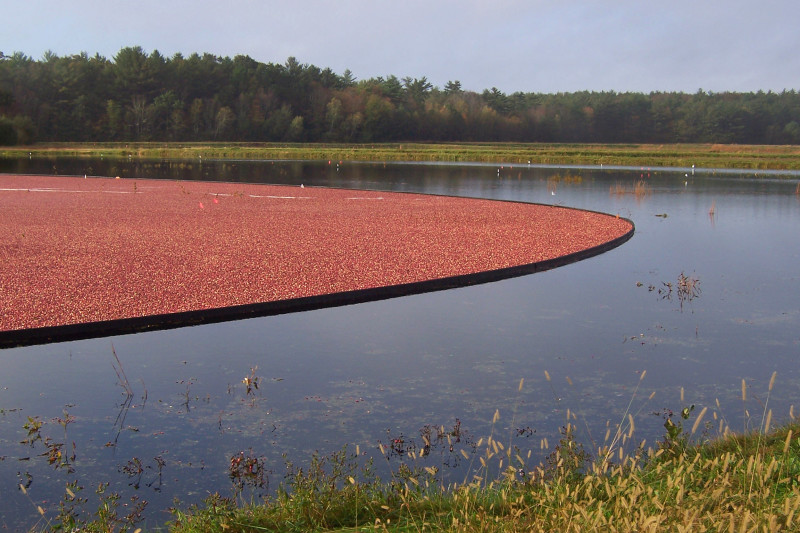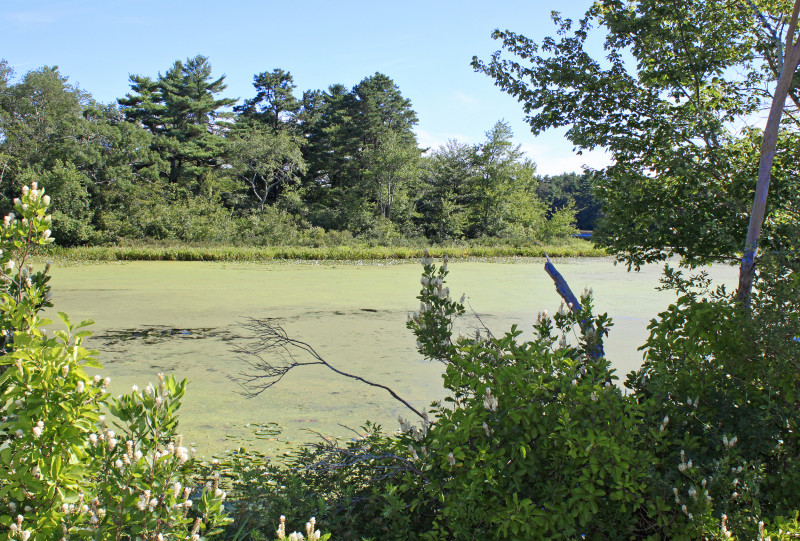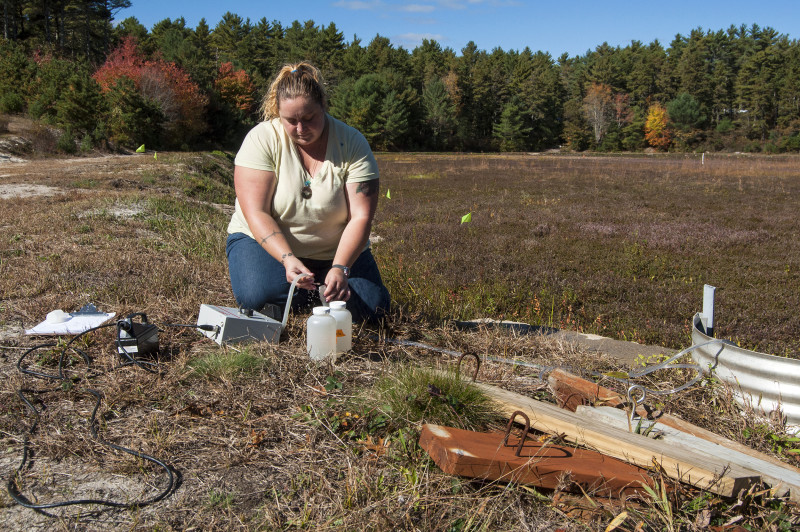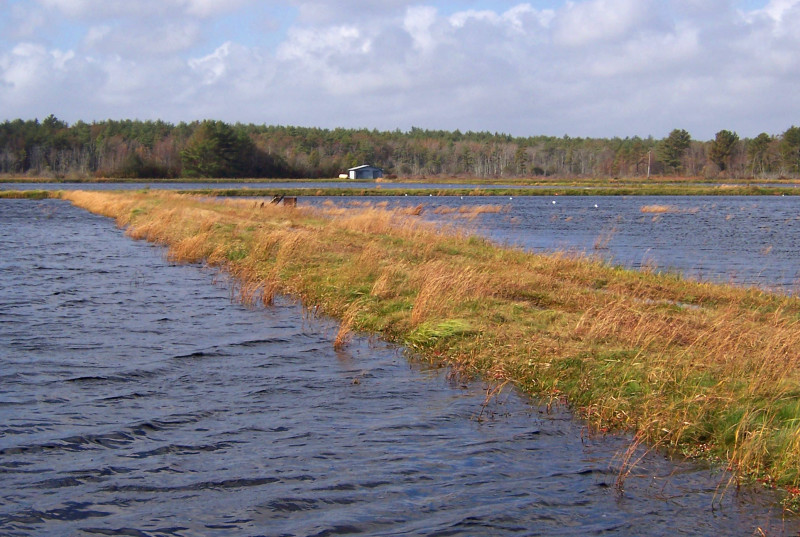How research on cranberry bogs could help solve a piece of Buzzards Bay’s pollution puzzle
Each October, the bogs lining local country roads glisten crimson as Massachusetts’ famed cranberry harvest kicks into full swing. Harvesters flood the fields, corralling the tiny red berries that pop to the surface so they can be whisked away and prepared to grace our Thanksgiving tables.

Fall’s flooded cranberry bogs are scenic — but with all that flood water come nutrients, the biggest type of pollution fouling Buzzards Bay.
The Buzzards Bay region is home to approximately 20 percent of the nation’s commercial cranberry crop. Those bogs are concentrated around the Weweantic River, the Bay’s largest river, including the towns of Carver, Plymouth, and Wareham.
Fall’s flooded cranberry bogs are certainly scenic, and they play an important role in our region’s culture and economy. But with all that flood water after each harvest come nutrients: a vital fertilizer for crops, but also the biggest type of pollution fouling Buzzards Bay. Two types of nutrients — nitrogen and phosphorus — can pollute our ponds, rivers, harbors, and estuaries when too much gets into the water.
Murky, nitrogen-polluted water has plagued the Weweantic River for years. Eelgrass beds have died off, leading to less habitat for underwater species, and low oxygen levels don’t allow fish to thrive.
Most of the Bay’s nitrogen pollution comes from wastewater, including septic systems and wastewater treatment plants. Other sources include lawns, farm fields, and stormwater runoff. But there’s another piece of the nitrogen pollution puzzle that’s been harder to pinpoint: cranberry bogs.
Now, a research project spearheaded by the Coalition is beginning to help scientists, cranberry growers, and decision-makers better understand the amount of nutrients flowing in and out of cranberry bogs.
How much pollution comes from cranberry bogs?

Nutrients like nitrogen and phosphorus fuel the growth of algae on local rivers and ponds, such as here on Parker Mills Pond in Wareham.
The simple answer to this question is, we’re not quite sure yet.
“There are lots of studies about the impacts of things like septic systems on water quality,” said Rachel Jakuba, science director with the Buzzards Bay Coalition. “But we were working with really limited science about cranberry bogs.”
Prior to this project, there were only two existing studies in Massachusetts that estimated the amount of nitrogen flowing in and out of cranberry bogs. One study from 1995 examined a now-uncommon type of bog and found that the bog contributed a significant amount of nutrients. In the other study, completed in 2005, researchers looked at six different bogs. But they found a wide range of pollution effects, which made it difficult to use the information to make recommendations for managing cranberry bogs.
So in 2011, the Coalition set out to learn more. Partnering with the UMass Cranberry Station, the Marine Biological Laboratory in Woods Hole, the Cape Cod Cranberry Growers’ Association, and the town of Carver, the Coalition launched a study to see how nutrients move in and out of six cranberry bogs around the Weweantic River and the Wareham River.
Specifically, researchers wanted to figure out how nutrients move in and out of two common types of bogs. The previous studies lacked details about how nutrient effects vary depending on the size, location, and management of bogs.
“The information we had to work with before didn’t take into account current cranberry agricultural practices or different styles of cranberry bogs,” said Jakuba, who’s leading the cranberry study for the Coalition. “This study is updating our understanding and making it more relevant to today’s landscape.”
How do scientists measure pollution from cranberry bogs?

Researchers with the UMass Cranberry Station are collecting water samples from six local cranberry bogs. These samples will be analyzed for nutrients at the Marine Biological Laboratory.
On a sunny afternoon one October, researchers with the UMass Cranberry Station gathered at a bog in Myles Standish State Forest to collect water samples. Using pumps, rubber hoses, and plastic jars, the researchers took samples from underground wells within the bog, at the spot where water exits the bog, and further downstream of the bog. All of the samples are sent to the Marine Biological Lab, where scientists analyze them for nitrogen and other nutrients.
The UMass bog is one of six being monitored as part of this research project: two in Carver, two in Wareham, and one each in Plymouth and Middleborough. Collectively, these bogs represent two different types of cranberry bogs. One type discharges water to a long, winding channel that eventually leads to the Weweantic River. In the other type of bog, water flows in and out of the same pond or stream channel.
Over two years, researchers collected and analyzed more than 650 water samples from these bogs. Samples were taken from both surface water and groundwater at regular intervals, as well as during harvest and winter floods.
What have we learned about nutrient pollution from cranberry bogs so far?

According to early research findings, nutrients appear to be released in bursts from cranberry bogs, such as at the end of the harvest flood.
The cranberry study has already yielded important and intriguing results for researchers.
“It seems to be very episodic,” said Jakuba about the nutrients that flow out of cranberry bogs. “Nutrients tend to be concentrated in small bursts during large movements of water.”
One of these “bursts” appears to take place at the end of the release of flood waters after harvest. Researchers have measured more nutrients at the end of the flood, when water is coming out of the sediment at the bottom of the bog. Summer rainstorms may also cause more nutrients to flow off bogs into nearby waterways.
This is the type of data that researchers hope to use to make management recommendations for cranberry growers that will reduce pollution and protect clean water, according to Jakuba.
“For instance, could growers release the first three-quarters of flood waters because nutrient concentrations are low, and only treat the remaining one-quarter for nutrients? If you’re only treating a fraction of your flood water, that’s much more logistically and economically feasible.”
But before researchers come to any hard conclusions about the effects of cranberry bogs on water pollution, they need to refine these results by collecting even more data. Over the next 18 months, researchers will use automated sampling machines to draw water samples during some of these critical times, such as when flood waters are released after harvest and during heavy summer storms.
Once this rigorous data collection is complete in 2016, the Coalition and its partners will be able to develop models that show how nutrients are coming off cranberry bogs and getting into local streams, ponds, and rivers, where they can become pollution.
“This study has the potential to directly lead to changes in farming practices that will reduce nutrient pollution to the Bay while sustaining cranberry yields,” said Jakuba. “Farmers will be able to implement specific, targeted management strategies that help slow nutrient runoff during periods when we know the most nutrients are coming off the bogs.”
On a larger scale, the results of the cranberry study will help inform restoration plans for the Weweantic River and other waterways with large concentrations of cranberry bogs. By learning how much water pollution to attribute to cranberry bogs, decision makers can effectively target the most critical nutrient sources when developing recommendations for pollution reductions.
In other words, the cranberry study will be a big step toward solving the nitrogen pollution puzzle in Buzzards Bay.